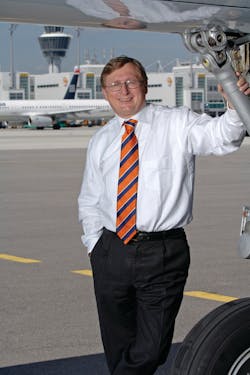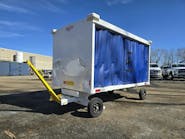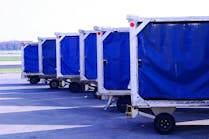Munich Airport Begins $2.7 Billion Infrastructure Expansion
Bavaria’s aviation experts called it a “hot summer.” The reference was not just to the sweltering heat across Germany, but also to the rising tensions among environmental groups and local residents who tried for six years to stop a proposed third runway at Munich Airport (MUC), and the regional government that finally cleared the way for its construction last July.
The additional runway, when completed by 2015, will enable 120 planes to takeoff and land at MUC per hour, up from the current 90 flights per hour. Airport officials contend they should be able to handle some 58 million passengers by 2025, up from 35 million in 2010.
Besides constructing a third runway, MUC is also building a new satellite facility to meet the additional passenger capacity at the airport’s Terminal 2 and increasing the number of gate positions for aircraft. The satellite facility will also go into operation in 2015.
MUC’s ambitious expansion project, which also includes adding to its cargo capacity, will further bolster its position as Germany’s second largest airport after Frankfurt am Main Airport (FRA).
SUBSTANTIAL GROWTH
In an interview with Ground Support Worldwide, Michael Kerkloh, the chairman of the board of Flughafen Munchen GmbH, the airport’s managing agency, described the government’s recent clearance of the new runway as the “most important decision” for MUC.
Kerkloh says MUC, as a prospering aviation hub, has already made a substantial contribution to the economy and employment in Bavaria. Since its opening in 1992, the airport’s traffic has increased considerably. Some 35 million passengers and 390,000 takeoffs and landings were recorded in 2010, a three-fold increase in passenger traffic and a two-fold increase in the number of aircraft movements since its first year of operation. Currently, MUC maintains regular links to more than 220 destinations in 88 countries.
The new satellite terminal is designed as an addition to the existing baggage sorting hall on the apron to the east of Terminal 2. When work is completed, the satellite will be an operational and functional component of Terminal 2 with a 600-meter (1,968-feet) pier providing space for a total of 52 gates. Also, the creation of 27 aircraft park positions adjacent to the new facility will more than double the number of nonremote aircraft stands serving Terminal 2.
The satellite is not a standalone terminal. Passengers will use the check-in and ticket desk and the arrivals area in Terminal 2. The new facility will be linked to Terminal 2 via an underground rail system. Automatic trains will take passengers to the satellite facility in less than a minute.
The construction work, scheduled to start sometime in the fourth quarter, will not be easy since the expansion measures are being carried out at the airport in the midst of daily operations. Much of the building will be built not only above the baggage handling hall, but wrap around MUC's eastern control tower.
At a press conference to announce first-half 2011 business, Kerkloh had this to say: “In a sense, this amounts to open-heart surgery on the airport. The various subprojects, with their tightly intermeshed timetables, will have to follow a tight script if we want to put a fully functional overall system into operation by 2015.”
‘LOOK EAST’ STRATEGY AND BEYOND
FMG executives are pursuing what local aviation circles describe as the airport’s “look east” strategy aimed at increasing its links with Asia.
Kerkloh has recently visited a number of Asian countries with the intention of luring Asian airlines to Munich and intensifying his contacts with Asian airports and governments.
“Traffic to Asia has grown in an impressive manner in the past years because of Munich Airport’s development as a hub,” Kerkloh explains. “We have, for example, about 135 weekly departures to Asia, five times as many as 10 years ago.”
The latest newcomers are Singapore Airlines and ANA, which have been operating from Munich since last year and have daily flights to Singapore and Tokyo, respectively.
“Also of key importance for us,” Kerkloh adds, “is the increase in frequencies by Lufthansa which, meanwhile, operates all its long haul flights on a daily basis.”
Munich is also interested in attracting carriers from the Gulf.
“Qatar Airways has increased its connections this year to Doha to 11 weekly frequencies,” Kerkloh adds. “Emirates will use the Airbus A380 aircraft from January next year for one of its two daily flights to Dubai.”
MUC is also not neglecting other important regions. North America, for example, “continues to be a very important market,” Kerkloh emphasizes. Munich airport offers 107 weekly takeoffs to 14 destinations in the United States and Canada though Kerkloh is also keen to get other airlines and destinations in the airport’s flight plan. He confirmed that he is in “active contact” with some airlines in North America, but would not reveal their names.
“We were very pleased when Lufthansa recently announced that it will have a new connection from Munich to Mexico City next year,” Kerkloh adds.
In related news, FMG also noted in a press release last July that MUC saw particularly strong gains in the number of travelers on flights to and from the “BRICS” countries: Brazil; Russia; India; China; and South Africa, all of which are seeing their countries’ economies growing at a 5-10 percent clip. Each of the BRICS countries, which together represent 40 percent of the world’s population, is the destination of at least one flight per day from MUC. The passenger volume on routes to these five growth markets increased by an average of 26 percent during the first half of the year to a combined total of more than 900,000 passengers.
CARGO INITIATIVE
Recognizing the business potential inherent in cargo traffic, MUC is also building up the cargo segment. Kerkloh believes cargo traffic offers even greater growth opportunities than passenger traffic.
During the first half of 2011, the airport handled nearly 145,000 tons, a 14 percent increase over the year-earlier period – an all-time record for the time frame. In order to keep pace with the steadily rising cargo volume, MUC will construct a new building for forwarding agents on an 18,000 square meter (59,000 square feet) parcel, which will be used by five major forwarding companies by next summer.
The future development of the cargo business at MUC would certainly be stimulated by specific trends in passenger traffic because a large part of the airport’s cargo business is transported in passenger aircraft belly.
“Since we expect an over-proportional rise in long-haul passenger traffic,” Kerkloh says, “an over-proportional growth in cargo can also be expected.”
The airport chairman declared that traffic in the first half of 2011 had been the best marks achieved by MUC in any first-half period.
“Never has Munich Airport clocked so many passengers in the first-half of a year,” Kerkloh claims.
Of Europe’s 10 leading airports, only Barcelona had surpassed Munich’s growth in passenger traffic.
“Creating quantity and safeguarding quality,” Kerkloh says, “that will be our task for the coming years.”
ABOUT THE AUTHOR: Manik Mehta is a New York-based journalist with extensive experience covering aviation, including ground support, airports, airlines, infrastructure, and passenger/cargo traffic. From his New York base, Manik travels frequently to Europe and Asia.






